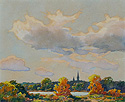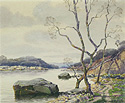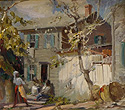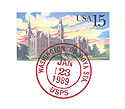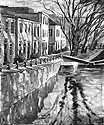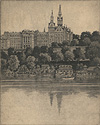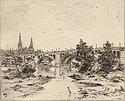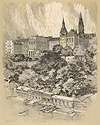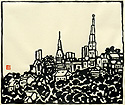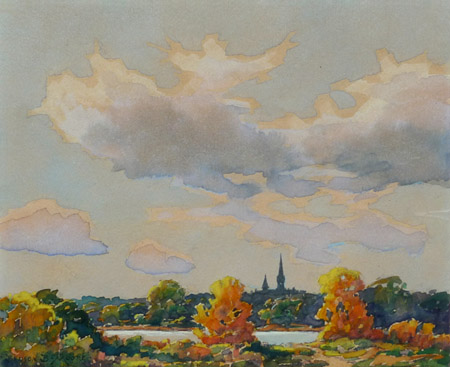
Healy Hall from Roosevelt Island
Benson Bond Moore (1882 – 1974)
With Georgetown Impressions, the art collection celebrates several recent acquisitions, displayed to coincide with the John Carroll Weekend in late April. This major alumni event which meets in a different city each spring will be convening in Washington, D.C., for the first time in twenty years. The exhibition is drawn primarily from the University Art Collection, with some related selections from the University Archives. Several of these historic views have never before been exhibited at Georgetown. With approximately 32 prints, 9 paintings and other associated objects, the Special Collections Research Center reveals a prominent, yet little-known aspect of its collecting efforts from the past several decades.
View of Georgetown D.C.
E. Sachse & Company Lithography (Active 1851-1873)
1852
Color lithograph
Library Purchase
1111.1.222
This scenic, distant view of Georgetown shows its clustered buildings and churches from a hilltop perspective, with the ships circling in the Potomac on their way to and from the bustling commercial port. The lithographer, Edward Sachse, was a native of Germany who immigrated to America in the late 1840s. He and his brother Theodore established a successful commercial lithography firm in Baltimore which produced these tremendously popular “bird’s-eye” panoramic views up until Edward’s death in 1873. Since they predate the advent of photography, these views are highly prized for their historical accuracy in capturing the dwellings, buildings and topography as they appeared at the time.
The Astronomical Observatory of Jesuits College at Georgetown D.C.
Unidentified artist
Lithograph
This naïve rendering of the Observatory provides the physical dimensions of the building, completed in 1844, and the scientific specifications for its telescope(s) in the bottom margin. Printed identically on front and back, it appears to be a rare lithographic proof intended for an illustrated volume.
The Philodemic Grand March
A. Hoen & Co. Lithography
1854
Color lithograph
This small color lithograph, like the Observatory engraving in the Catalogue (below), is probably derived from an 1830s painting by James Alexander Simpson, the first instructor of drawing and penmanship at the college. Two of Simpson’s college landscapes are on view in Carroll Parlor (107 Healy Hall), while three others are hanging in administrative offices. The lithograph was originally printed on the sheet music cover (later cut out) of The Philodemic Grand March by Pedro A. Daunas. The illustration shows the campus from the northwest with Old North pictured to the left and Old South (the first building on campus), Mulledy and Gervase to the right. Founded in 1830, the Philodemic Society is one of the oldest collegiate debating clubs in the country.
Astronomical Observatory, Georgetown College, D.C.
James Alexander Simpson (1805 – 1880), H. Weber
Engraving
Georgetown University Archives
Library Purchase
1111.1.4188.1
The very first printed Catalogue of Georgetown College was published for the 1850-51 school year with an engraving of the Observatory as its frontispiece. The Catalogue outlined the curricula of the boys’ preparatory school, which included rhetoric, philosophy, poetry and mathematics. It also listed the names of the 152 college students and the program for the commencement exercises of July 24, with the recipients of the various medals awarded in each of the academic disciplines.
View of Georgetown, Washington and Alexandria…
Frank Leslie’s Illustrated Newspaper
1861
Wood engraving
Library Purchase
1111.1.5659
Quarters of the Sixty-Ninth (Irish) Regiment…
Harper’s Weekly
1861
Wood engraving
These wood-engraved views of Georgetown during the Civil War were published in the popular periodicals of their day. The Harper’s Weekly image shows the 69th Regiment, New York National Guard in front of the building that preceded Maguire, where they arrived on May 4, 1861. As recorded in John Gilmary Shea’s History of Georgetown College (1891), these troops arrived at Georgetown, which provided commanding views of the surrounding city and countryside from upper-level windows, on the same day that the United States Government notified its president, Father John Early, of their imminent occupation:
There was little time given to make ready for the unexpected guests, for before night closed in, the courts of the College echoed with the clank of muskets… The new building, and the students’ Refectory building were assigned to the regiment; the Colonel, Corcoran, occupying the recreation room of the Jesuit Fathers. The regiment, nearly 1,400 strong, was in good discipline, and beyond the necessary inconvenience caused by the occupation of part of the college buildings, gave little trouble or annoyance. (p. 204)
The 69th Regiment remained for twenty days, followed by the 79th New York National Guard in June.
View of Fowler’s Hill
Unidentified artist
Oil on canvas
Library Purchase 2008
2008.13.1
In 1880 an itinerant painter from Italy visited a family farm a quarter of a mile outside of Georgetown, and imposed upon the family’s hospitality. The hill upon which the family lived was known to locals as Fowler’s Hill. In lieu of rent, which he could ill afford, the visitor painted a picture of their home. The Library recently purchased his painting from a friend of the Fowler’s Hill family’s grandson, Jack Maher (1919 – 2002).
The painting presents an intimate, pastoral view of a small farmhouse and some of its outbuildings. A tall cedar tree stands in front of the house, and apricot trees are seen behind. The foreground shows a meandering path bordered by grasses and flowering wild garlic. In the far background the Potomac can barely be discerned. Although the original location of the house can’t be definitively determined, it was surely within sight of Georgetown’s Astronomical Observatory. The Observatory was built in 1844 and co-existed with small farms on the hill for quite some time, as can be seen in this early photograph (below) from the University Archives.
Georgetown House [Yellow House, R St.]
Aline Fruhauf (1907 – 1978)
1959
Lithograph; 25/30
Library Purchase 1997
1997.1.5
New York caricaturist Aline Fruhauf moved to Washington, D.C. when her husband was assigned to the Naval Medical Center in 1944. Soon afterwards she exhibited her work at the main branch of the D.C. Public Library. Fruhauf missed the hustle and bustle of New York life, and “as compensation, I sought out curious houses and landscapes and applied to them the same reduction to lowest terms I had previously applied to humans,” as she explained in her 1987 memoir, Making Faces. While riding north on a streetcar, she was “drawn as if by a magnet to the yellow house on R Street in Georgetown.” Originally built in 1854, Fruhauf likened it to the houses Charles Addams drew for the New Yorker.
Aline Fruhauf made sketches of the house from the second floor window of the Georgetown public library across the street. In her book, she recalled its architectural features: “Its tiled mansard roof, as somberly iridescent as the feathers of a dark pigeon, was the inverted peach-basket hat of a dowager of distinguished lineage to whom fashion was not only superfluous but highly undesirable.” Twelve years later Fruhauf made a lithograph from her original painting, and found that the house was on the market for sale. She took the opportunity to tour the interior and meet its owner.
George Washington’s Headquarters [Old Stone House]
Syd Browne (1907 – 1991)
1943
Lithograph; edition of 25
Library Purchase 1982
1982.8.2
Healy Hall from Roosevelt Island
Benson Bond Moore (1882 – 1974)
Watercolor
Library Purchase
1111.1.6112
The Potomac Along Rock Creek Park
Benson Bond Moore (1882 – 1974)
Watercolor
Library Purchase
1111.1.6111
Stoop Sitting in Old Georgetown
Gladys Nelson Smith (1890 – 1980)
c. 1925
Oil on canvas laid on board
Library Purchase
1111.1.1010
A Kansas native who graduated from the University of Kansas School of Fine Arts, Gladys Nelson Smith moved permanently to Washington D.C. when her husband became a federal government special attorney in 1924. For the next six years she studied portrait painting at the Corcoran School of Art and participated in several biennial exhibitions there.
Smith became interested in the neighborhood of Georgetown and made a series of ketches and paintings of its historic homes and quaint narrow streets. Her painting Stoop Sitting in Old Georgetown was exhibited at the artist’s 1984 Corcoran Gallery retrospective and was purchased by the University in 2001. As curator Linda Simmons wrote in the exhibition catalogue, “the landscape elements of curling tree branches and a rough board fence are given further pictorial quality by the figures on the stoop and the bedding hung out to air, events not to be seen so often today.”
The exact location of the house depicted in the painting is not known. Earlier in the twentieth century, when Georgetown was still a port village, row houses such as this extended closer to the waterfront, where shops, offices, and apartments stand today.
These blocks were home to some of the city’s African-American communities; Stoop Sitting in Old Georgetown may be a record of life in one such area.
Georgetown 2001
Sr. Mary Grace Thul
2001
Color woodcut; 10/57
Library Purchase
1111.1.682
A Dominican nun since 1962, Sister Mary Grace has maintained an active art career with numerous commissions for liturgical events and venues. Sister Mary Grace studied at the University of Cincinnati College of Applied Arts and taught art in public schools before finding her monastic vocation. She moved to St. Dominic’s monastery in Washington, D.C. in 1989 for several years before relocating to Delaware. In her vivid color woodcut, the Jesuit monogram and surrounding sun cast their rays of knowledge and spiritual illumination over the spires and towers of the Healy building.
Healy Hall
Joan Zwack
c. 1985
Lithograph with hand coloring; 22/500
Alumni Association Commission
Joan Zwack is a locally and nationally recognized historic preservation artist known for her depictions of historic buildings and homes. Zwack was honored as the bicentennial artist of Montgomery County, Maryland, and was subsequently commissioned by the Georgetown Alumni Association to draw a series of buildings on campus.
Healy Building from the Front Gates
Agnes Melissa Jordan
c. 1970
Oil on canvas laid on board
Gift of Paul J. Goda, S.J.
2006.10.1
1st Day Cover stamp and folder
John Morrell (b. 1952)
1989
Offset lithograph
Georgetown University Archives
South View of Georgetown College
John L. Smithmeyer & Co., Architects (1832 – 1908)
1875
Ink and watercolor on paper
Library Purchase
1111.1.959
Georgetown College
John L. Smithmeyer & Co., Architects (1832 – 1908)
1877
Engraving
This rare surviving watercolor by architect John L. Smithmeyer shows the elevation of the buildings on the south side of campus. It was made in preparation for designing the Healy building, which was completed between 1877 and 1879. The Flemish Romanesque building, which has become the icon of campus and community, was named for Georgetown’s 28th president and master-planner of the building, Father Patrick F. Healy, S.J., the first African-American president of a major American university. John Smithmeyer and his assistant, Paul J. Pelz, went on to design the Library of Congress Thomas Jefferson building in 1886-92.
The accompanying engraving, printed in 1877 by Smithmeyer and Pelz, shows the plan for the front façade and the adjoining Old South building, which was later destroyed to build Gervase.
Book design and illustrations for Ye Domesday Booke
Alexander O. Levy (1881 – 1947)
1933
Yearbook; offset lithograph of original watercolor; six etchings
Georgetown University Archives
Alexander Levy was born in Bonn, Germany, and trained in Cincinnati and New York with notable American painters Frank Duveneck, William Merritt Chase and Robert Henri. Levy went on to become a successful illustrator, printmaker and book designer in Buffalo, New York. The 1933 Domesday Booke, published in Buffalo (Baker, Jones, Hausauer, Inc.) with watercolor illustrations and designs throughout by Alex Levy, included these six etchings of buildings and scenes from Georgetown’s campus. Published by the senior class, the yearbook was dedicated to the past presidents, “that the memory of these and other leaders of Georgetown University may not be lost to those who pass through her portals.”
The Chesapeake & Ohio Canal
The Chesapeake and Ohio Canal Company was chartered in 1825 to acquire the rights of the Potomac Company, formed by George Washington and associates after the Revolution to improve navigation on the Potomac. That venture had attempted to re-form the Potomac itself, but the flow of the river proved too erratic. The C&O Canal promoters instead decided to make a separate canal paralleling the river.
The C&O Canal is one of the most intact and impressive survivals of the American canal-building era. While recognizable segments of other early-19th-century canals exist and while a few other canals of the period have been rebuilt for modern shipping, the Canal is unique in that it remains virtually unbroken and without substantial modification affecting its original character for its entire length of some 185 miles.
Although the builders of the canal could hardly have predicted it, their work led to the preservation of a large portion of the Maryland bank of the Potomac in a relatively unspoiled state. Natural growth reclaimed much of the land after the canal closed in 1924, and the transfer to the National Park Service in 1938 resulted in its preservation for its historical, natural, and recreational values. The fact that the entire towpath to Cumberland may still be traveled and the survival of many of the principal canal structures afford the many hikers and bicyclists who follow the route a fine opportunity to appreciate the magnitude of this historic engineering achievement.
C & O Canal, Georgetown
Eleazer Hutchinson Miller (1831 – 1921)
1881
Two etchings
Library Purchase
1991.3.40 (left), 1991.3.41 (right)
Eleazer Hutchinson Miller’s obituary at the age of 90 hailed him as “the first artist of national reputation to establish his home and studio in Washington.” Noted primarily for portraiture, Miller also became fascinated with the medium of etching on copper, and frequently exhibited with the New York Etching Club. This 1881 view along the Chesapeake and Ohio Canal in Georgetown shows buildings belonging to a flour mill along the south bank. The two impressions displayed here were printed in 1984 from Miller’s original copper plate in a restrike edition of 50 prints by Pittsburgh artist Helen King Boyer.
Along the Canal, Georgetown
Syd J. Browne (1907 – 1991)
1943
Lithograph; Edition of 25
Library Purchase 1982
1982.8.1
A resident of Brooklyn, Syd Browne attended both the Pratt Institute and the Art Students League. As a painter and etcher, Browne concentrated primarily on landscapes, townscapes, and marine views. During his lengthy career, Browne exhibited at world renowned showcases such as the Paris Exposition in 1937 and the New York World’s Fair in 1939. Browne is also noted for having work displayed at the Library of Congress.
Old Georgetown Canal (Plates 1 and 2)
Hirst Dillon Milhollen (1906 – 1970)
1935
Etchings; each in an edition of 40
Library Purchase
1111.1.632 (left), 1111.1.633 (right)
A distinguished local artist who ran the Library of Congress Prints and Photographs Division for many years, Hirst Milhollen specialized in etchings of architectural history, as in these views of the buildings and locks along the canal towpath in Georgetown. Milhollen was also president of the Society of Washington Etchers, and exhibited his work with Joseph Himmelheber and Benson Bond Moore, also represented in this exhibition.
The Chesapeake & Ohio Canal
The Chesapeake and Ohio Canal Company was chartered in 1825 to acquire the rights of the Potomac Company, formed by George Washington and associates after the Revolution to improve navigation on the Potomac. That venture had attempted to re-form the Potomac itself, but the flow of the river proved too erratic. The C&O Canal promoters instead decided to make a separate canal paralleling the river.
The C&O Canal is one of the most intact and impressive survivals of the American canal-building era. While recognizable segments of other early-19th-century canals exist and while a few other canals of the period have been rebuilt for modern shipping, the Canal is unique in that it remains virtually unbroken and without substantial modification affecting its original character for its entire length of some 185 miles.
Although the builders of the canal could hardly have predicted it, their work led to the preservation of a large portion of the Maryland bank of the Potomac in a relatively unspoiled state. Natural growth reclaimed much of the land after the canal closed in 1924, and the transfer to the National Park Service in 1938 resulted in its preservation for its historical, natural, and recreational values. The fact that the entire towpath to Cumberland may still be traveled and the survival of many of the principal canal structures afford the many hikers and bicyclists who follow the route a fine opportunity to appreciate the magnitude of this historic engineering achievement.
Francis Scott Key Bridge
To accommodate growing motor traffic between the District of Columbia and Virginia, the Army Corps of Engineers built the Key Bridge between 1917 and 1923. The Classically inspired structure, designed by Nathan C. Wyeth, is composed of eight arches: the original seven arches, plus an eighth added in 1939 to span the George Washington Memorial Parkway. The original road deck included two traffic lanes, a center lane for trolley tracks, and two sidewalks.
Wyeth’s widow, Dorothy Lawson Wyeth, recalled how her husband had designed a far more elaborate, two-level bridge “with beautiful approaches.” However, wartime economics forced the government to abandon Wyeth’s initial proposal in favor of a less-costly single-level version. The decision to severely alter the original design “dashed the hopes of the young architect.” Despite Wyeth’s disappointment at the modified design, the structure conveys his original design intent.
The Key Bridge replaced the older Aqueduct Bridge, which was originally built to transport canal boats from the C&O Canal in Georgetown to the Alexandria Canal in Virginia, but was later converted to train and then motor traffic. The Aqueduct Bridge can be seen in the image from Frank Leslie’s Illustrated Newspaper and the University Archives photograph above.
Key Bridge View of Georgetown
James Sundquist (b. 1949)
c. 1980
Color lithograph
Art Collection purchase
James Sundquist received his undergraduate and graduate degrees in fine art and art history at George Washington University and exhibited in over a dozen local galleries from 1973-85. During this time he published an article in Historic Preservation Magazine (March/April 1979) on Architecture: An Artist’s Imprint. In it, Sundquist explained that the medium of traditional stone lithography was the most compatible for reproducing architectural subjects. As such, “The natural grain of the limestone drawing surface captures remarkably the texture of brick, concrete and stone buildings.”
Georgetown and Key Bridge
Unidentified artist (signed Ragan)
Oil on canvas
Library Purchase
1111.1.1135
View of Georgetown University and the Key Bridge
Martha Moffett Baché (1893 – 1983)
Oil on canvas laid on board
Library Purchase 2007
2007.19.1
Georgetown University
Benson Bond Moore (1882 – 1974)
c. 1930
Etching
Transfer from Father Repetti
1985.12.1
View of Georgetown from Key Bridge
Joseph Bernard Himmelheber (1902 – 1951)
1931
Lithograph
Gift of H. Hirston
1999.12.1
Our Washington as the Artist Sees It
Joseph Bernard Himmelheber (1902 – 1951)
Portfolio of 20 lithographs; one shown, with caption
Georgetown University
Un'ichi Hiratsuka (1895 – 1997)
1985
Woodcut; 8/30
Gift of Un'ichi Hiratsuka
1991.23.1
With its autumn 1985 issue, The Washington Print Club Quarterly celebrated the ninetieth birthday of the distinguished Japanese woodcut artist Un'ichi Hiratsuka, who had lived in Washington since 1962, where he inspired and taught a generation of younger printmakers. Hiratsuka was honored in the exhibition Hiratsuka: Modern Master, at the Art Institute of Chicago in 2001, and featured in the exhibition of Japanese Ukiyo-e art at the Library of Congress the same year. His personal statement about this lovely woodcut view from Key Bridge follows:
Georgetown University in fresh, green color inspired this print. The symbolic focus of Georgetown [D.C.] is the beautiful view of Georgetown University. Furthermore, Georgetown is the focal point of Washington, and Washington, of the world! The university building can be viewed from all directions and contains the harmony of nature and architectural beauty which makes you feel its gracefulness and of being hand-in-hand with nature. To me it makes a perfect composition. ... The clock tower in the sky looks like a tower of elephant tusk! I don’t think I’ll find a similar sight in any other place in the world.
The Washington Canoe Club
Often mistakenly called Fletcher’s Boathouse, the Washington Canoe Club was designed by architect George P. Hales and built in 1904. The green shingle-style clubhouse with its two octagonal towers has changed very little over the years since it was—according to Club lore—built by club members using salvaged wood from burned-down barns. The building was designated a District of Columbia landmark in 1973 and in 1991 it was placed on the National Register of Historic Places.
The WCC was originally constructed on pilings in the Potomac River. Photographs taken in the 1930s show that the first floor of the front of the clubhouse was approximately 8-10 feet above the water line. The shoreline was then located at the northern edge of the building and a bridge provided access from land to rear facade of the building. During the 1960s, the Corps of Engineers demolished all but the remaining pier of the old Aqueduct Bridge, using the masonry to stabilize the Potomac’s eastern shoreline. As a result the water under the Canoe Club became stagnant and was subsequently filled with concrete. Shortly thereafter the area north of the Canoe Club was paved with concrete and now serves as the club’s parking area.
In the 1950s, ice floes pushed the building five feet downstream but the structure was jacked up and returned to its original location.
Boathouse, Georgetown
Jorge Cerdá Gironés (b. 1953)
1995
Oil on canvas
Library Purchase 2008
2008.8.1
Potomac Boat House from Key Bridge
Yolanda Frederikse
2006
Color screenprint; 8/12
Library Purchase 2008
2008.14.3









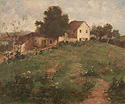

![Georgetown House [Yellow House, R St.]](/sites/default/files/images/georgetown_impressions__t_S1.jpg)
![George Washington’s Headquarters [Old Stone House]](/sites/default/files/images/georgetown_impressions__t_S2.jpg)

